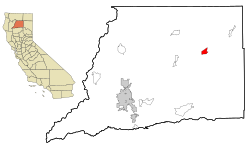Burney, California
| Burney | |
|---|---|
| census-designated place | |
 Location in Shasta County and the state of California |
|
| Coordinates: 40°52′50″N 121°40′0″W / 40.88056°N 121.66667°WCoordinates: 40°52′50″N 121°40′0″W / 40.88056°N 121.66667°W | |
| Country |
|
| State |
|
| County | Shasta |
| Area | |
| • Total | 5.201 sq mi (13.470 km2) |
| • Land | 5.196 sq mi (13.457 km2) |
| • Water | 0.005 sq mi (0.013 km2) 0.09% |
| Elevation | 3,195 ft (952 m) |
| Population (2010) | |
| • Total | 3,154 |
| • Density | 610/sq mi (230/km2) |
| Time zone | Pacific (PST) (UTC-8) |
| • Summer (DST) | PDT (UTC-7) |
| ZIP code | 96013 |
| Area code(s) | 530 |
| FIPS code | 06-09122 |
| GNIS feature ID | 0277481 |
| Website | City of Burney Website |
Burney is an unincorporated town and census-designated place (CDP) in Shasta County, California, United States. The population was 3,154 at the 2010 census, down from 3,217 at the 2000 census. Burney is located on State Route 299, about 4 miles west of its junction with State Route 89.
Burney has several areas for fly fishing, with wild brown and native rainbow trout in many nearby rivers and streams, including Burney Creek. Other attractions in the area include McArthur-Burney Falls Memorial State Park, home to the Burney Falls.
Burney was named after Samuel Burney, a settler in the area in the 1850s. Burney was found dead in the valley in 1857, which came to be called "the valley where Burney died," and finally just "Burney".
The town of Burney sits at the base of an extinct volcano called Burney Mountain. The peak is 7,863 ft tall (2,397 m).
The 2010 United States Census reported that Burney had a population of 3,154. The population density was 606.5 people per square mile (234.2/km²). The racial makeup of Burney was 2,685 (85.1%) White, 13 (0.4%) African American, 233 (7.4%) Native American, 7 (0.2%) Asian, 2 (0.1%) Pacific Islander, 61 (1.9%) from other races, and 153 (4.9%) from two or more races. Hispanic or Latino of any race were 265 persons (8.4%).
...
Wikipedia
